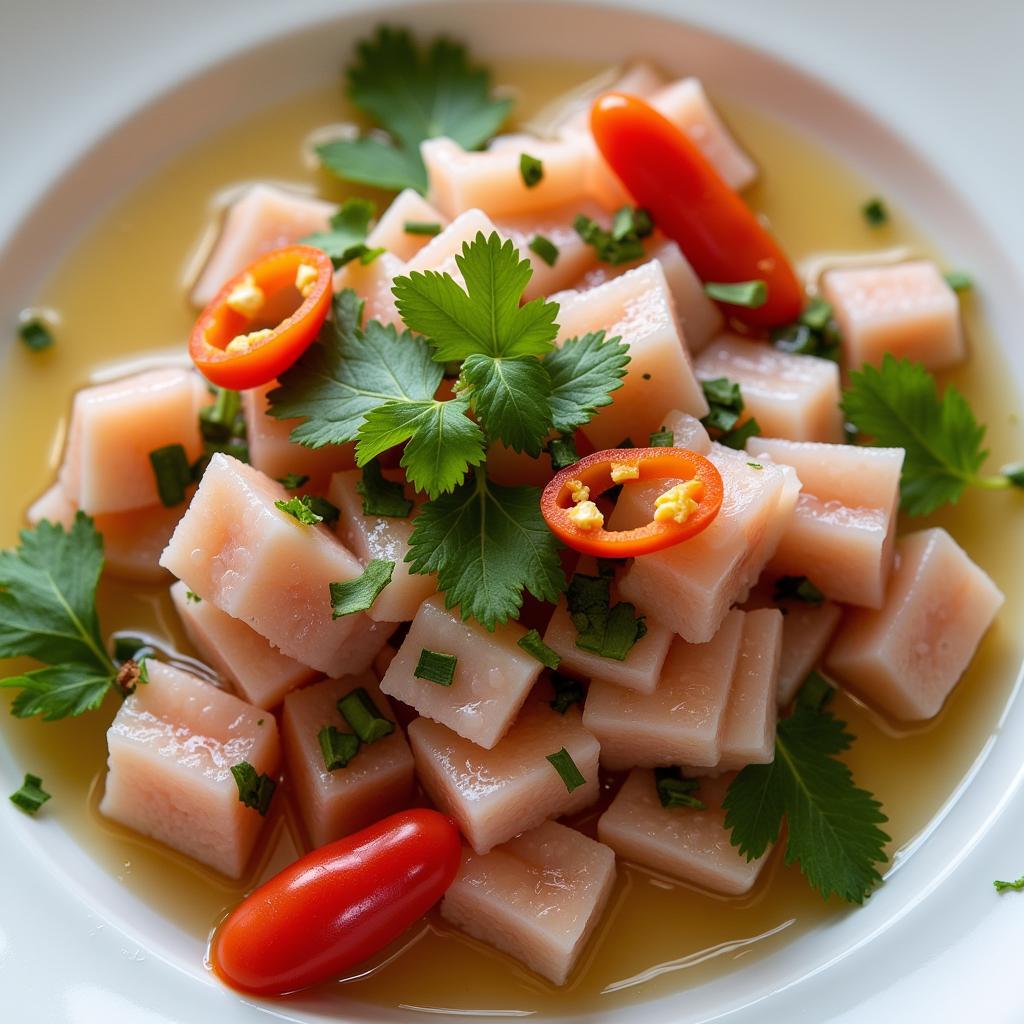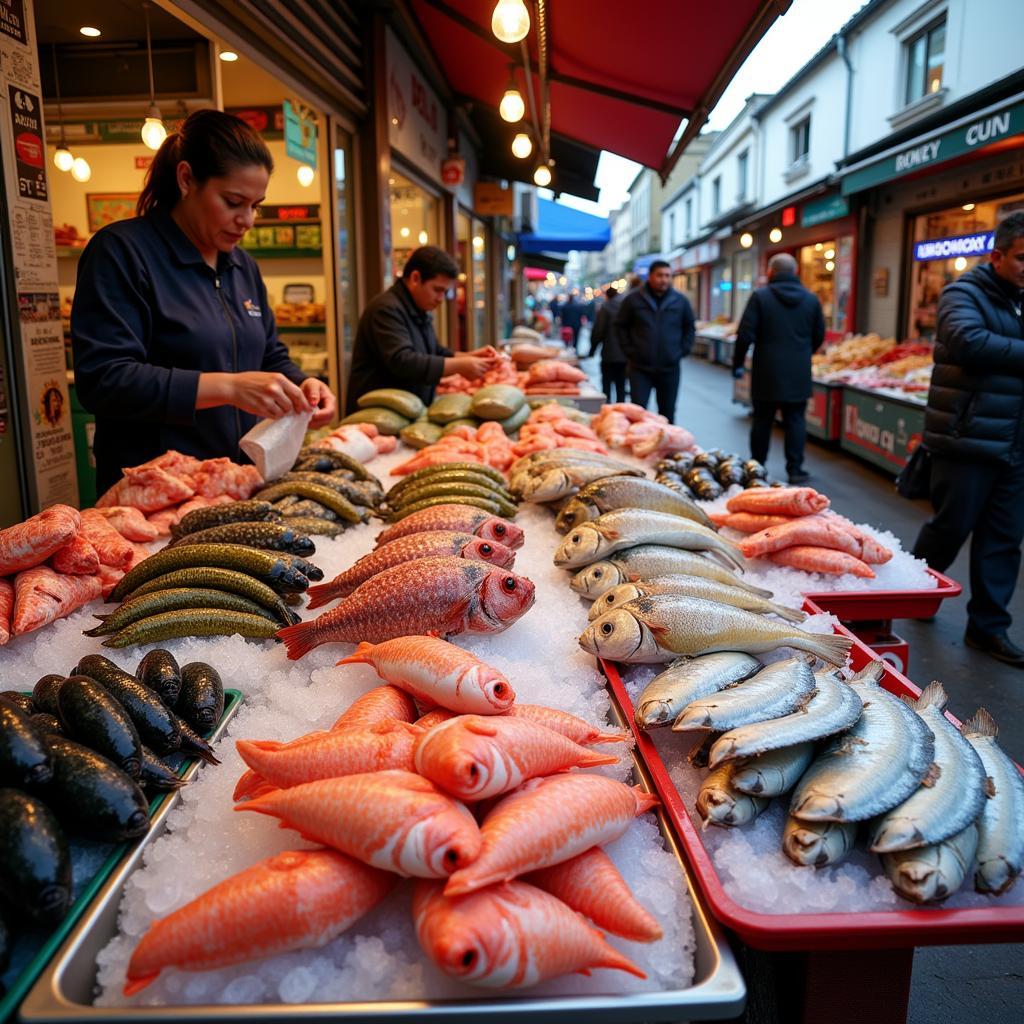Marinera Food, a vibrant tapestry of Peruvian cuisine, captivates the senses with its bold flavors and fresh ingredients. This culinary tradition, deeply rooted in the coastal regions of Peru, offers a unique and unforgettable dining experience. From the tangy ceviche to the hearty chupe de camarones, marinera food embodies the spirit of the Pacific Ocean and the rich cultural heritage of Peru.
 A vibrant plate of Peruvian ceviche, showcasing the fresh ingredients and bold flavors of marinera food.
A vibrant plate of Peruvian ceviche, showcasing the fresh ingredients and bold flavors of marinera food.
What is Marinera Food?
Marinera food refers to the cuisine of coastal Peru, heavily influenced by seafood and the culinary traditions of the region. It’s a celebration of fresh catches, vibrant spices, and indigenous ingredients, resulting in dishes that are both flavorful and visually appealing. What sets marinera food apart is its emphasis on simplicity, allowing the natural flavors of the ingredients to shine. Think bright citrus notes, spicy aji peppers, and the delicate sweetness of fresh seafood.
Key Ingredients in Marinera Cuisine
Marinera cuisine relies on a handful of key ingredients that give it its distinct character. Fresh seafood, including fish, shellfish, and seaweed, forms the backbone of many dishes. Aji amarillo, a Peruvian yellow chili pepper, adds a touch of heat and complexity. Lime juice provides a refreshing acidity, balancing the richness of the seafood. Other common ingredients include onions, cilantro, and potatoes, showcasing the diverse flavors of Peru.
Popular Marinera Dishes
From the internationally renowned ceviche to lesser-known regional specialties, marinera food offers a wide array of culinary delights. Here are some must-try dishes:
- Ceviche: Perhaps the most iconic marinera dish, ceviche consists of raw fish marinated in lime juice, seasoned with onions, cilantro, and aji peppers.
- Chupe de Camarones: A rich and creamy shrimp chowder, packed with potatoes, corn, and aji panca peppers. This comforting soup is a perfect example of the hearty side of marinera cuisine.
- Aji de Gallina: While not strictly a seafood dish, aji de gallina is a popular creamy chicken stew thickened with bread and walnuts, seasoned with aji amarillo peppers and often served with boiled potatoes and rice.
- Causa Rellena: A layered potato dish filled with various ingredients, such as chicken, tuna, or avocado, causa rellena is a versatile and satisfying option.
Exploring Regional Variations
Marinera food, while unified by its emphasis on seafood and fresh ingredients, also boasts distinct regional variations. Northern Peru is known for its spicier dishes, while the south favors heartier stews and chowders. Exploring these regional nuances adds another layer of depth to the marinera food experience.
“Marinera food is not just about the ingredients, it’s about the experience,” says renowned Peruvian chef, Maria Chavez. “It’s about sharing a meal with loved ones, enjoying the fresh flavors of the ocean, and celebrating the rich cultural heritage of Peru.”
Where to Experience Marinera Food
While you can find Peruvian restaurants around the world, nothing beats experiencing marinera food in its birthplace. Coastal cities like Lima, Trujillo, and Arequipa offer a plethora of dining options, from upscale restaurants to casual cevicherias. Immerse yourself in the vibrant atmosphere of a local market, where you can sample fresh seafood and interact with the passionate vendors.
 Fresh seafood at a Peruvian market, highlighting the importance of fresh ingredients in marinera food.
Fresh seafood at a Peruvian market, highlighting the importance of fresh ingredients in marinera food.
Conclusion
Marinera food offers a unique and unforgettable culinary journey. From its fresh ingredients to its bold flavors, it’s a cuisine that captivates the senses and leaves a lasting impression. So, whether you’re a seasoned foodie or simply curious about exploring new culinary horizons, marinera food is a must-try. Embrace the flavors of the Pacific and discover the magic of Peruvian cuisine. Remember to explore our food vocabulary in spanish pdf to enhance your culinary adventure! And for seafood lovers, check out our article on black mussels food.
FAQ
- What is the difference between marinera food and other Peruvian cuisine?
- What are some common vegetarian options in marinera food?
- What is the best time of year to experience marinera food in Peru?
- What are some tips for finding authentic marinera restaurants?
- What are some common beverages served with marinera food?
- What is the significance of aji amarillo in marinera cuisine?
- What are some essential kitchen tools for preparing marinera dishes at home?
“The beauty of marinera food lies in its simplicity,” adds Chef Chavez. “It’s about letting the fresh, high-quality ingredients speak for themselves.”
When you need support, please contact Phone Number: 02437655121, Email: minacones@gmail.com Or visit: 3PGH+8R9, ĐT70A, thôn Trung, Bắc Từ Liêm, Hà Nội, Việt Nam. We have a 24/7 customer service team.